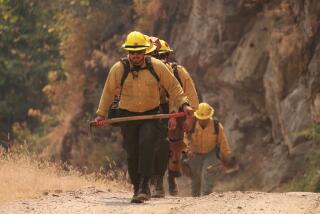The Unexpected Can Put Paramedics in the Line of Fire
For paramedic Robert Snyder, the call was like so many other injured cyclist calls: After falling from his bicycle on East Harvard Boulevard in Santa Paula, a man lay in the roadway, unresponsive and bleeding from a head wound.
What Snyder didn’t know was that the man had robbed someone and was running from the police when he took the spill.
Snyder tried to help, but to his surprise the man started to fight. That’s when Snyder saw the pearl handle of a pistol protruding from the man’s waistband.
He and his partner were lucky that night. They were able to wrest the gun from the man and neither was injured.
Such incidents point out the dangers that emergency medical personnel face on a daily basis.
Though none has been seriously injured in Ventura County, some agencies are discussing making body armor standard issue for employees who respond to medical emergencies. The protection is issued to firefighters and paramedics in Los Angeles County, who face a higher number of dangerous calls, and some officials think it would be a good way to prevent any problems here.
“You never know what you’re going into,” said Snyder, 25, the field operations supervisor for MedTrans Ambulance. Under a contract with Ventura County, MedTrans provides paramedic service for the county’s cities, except Ojai, Ventura and Oxnard.
In the past year, Thousand Oaks-based MedTrans has responded to about 27,000 calls throughout the county, most involving people with some sort of general illness. But 1,208 calls involved a shooting, stabbing, attempted suicide, drug overdose or assault.
These high-risk calls--gang shootings, domestic disputes involving weapons, and people under the influence of a controlled substance--put paramedics in the line of fire.
And sometimes, as Snyder discovered, something as simple as a fallen cyclist has the potential for something far worse. “The guys from the Police Department said he was involved in an armed robbery. Sure enough, it was a real gun and he was a robber,” Snyder said.
Paramedics across the county are taught to tread lightly when going into a dangerous situation. Size up the people around you, watch for weapons and don’t do anything to agitate the person who has been injured.
In many cases, police officers are the first line of defense for paramedics.
“Whenever there’s a violent call, we stage out of the area. We wait around the corner or down the block until the law enforcement agency clears it and says it’s OK to go in,” Snyder said.
But a wall of police officers cannot always prevent criminals from getting to those trying to do good.
In 1992, Fillmore Fire Chief Pat Askren was called to Palm Street to help a man who had been in a fight. Before the night was over, 51-year-old Askren had taken a hit from behind.
“It was a fight between two individuals that got out of hand. The person that did the attacking was standing on the sidelines as we were working on the individual whom I believe had been stabbed,” Askren said. “The guy came up from behind and hit me with his elbow between my shoulder blades, and that knocked me over the [stabbing victim].”
A Ventura County sheriff’s deputy was watching over the scene, but “the guy just jumped out of the crowd. Why he would take it out on us I don’t know,” Askren said.
Askren was not seriously injured. However, he said, “Now we always have someone facing the crowd.” In addition, Askren recently began carrying a can of chemical Mace on certain high-risk calls, he said.
One of the most dangerous situations for emergency medical personnel is the domestic dispute call, according to Dave Festerling, assistant chief with the Ventura County Fire Department. The reason? “We’re not welcome,” he said.
“We walk into a family disturbance situation and there’s always somebody who’s not in control of their faculties to know why we’re there. When you can get people to understand that you’re there to help and not take sides, you can do your job better,” Festerling said.
He said that in addition to being aware of your surroundings once on the scene, the key to staying safe is being ready for anything.
“The calls that are scary are the ones you get and [the dispatcher] doesn’t have all the information. The ‘man down’ call is a common call. But we get there and the victim has a blade sticking out from between his third and fourth rib,” Festerling said.
While body armor has been discussed among management of the County Fire Department for the last couple of years, it has yet to be made a part of the uniform. “It’s something that’s coming to us in the future,” Festerling said.
MedTrans provides bulletproof vests for each of its ambulances, Snyder said. The vests were purchased from the Army National Guard after the Los Angeles riots, he said. The paramedics are not required to wear them.
In fact, Rob Scott, who works out of the firm’s Moorpark office, has pulled his vest out of its holder once this year. He questions their effectiveness.
“They wouldn’t do any good unless you wear them all the time,” he said. “But I don’t see any reason for that.”
Tony Norton, operations manager for Gold Coast Ambulance in Oxnard, agrees that such protection is not necessary in Ventura County.
“I wouldn’t want the false sense of security,” Norton said.
“Here in Ventura County, however high our crime rate may be, we’re certainly a lot better than some of the other major metropolitan areas,” Norton said.
In the 18 years Norton has been with Gold Coast Ambulance, no paramedic has been seriously injured in an attack.
“We have police officers who are highly trained to take care of these situations,” he said.








